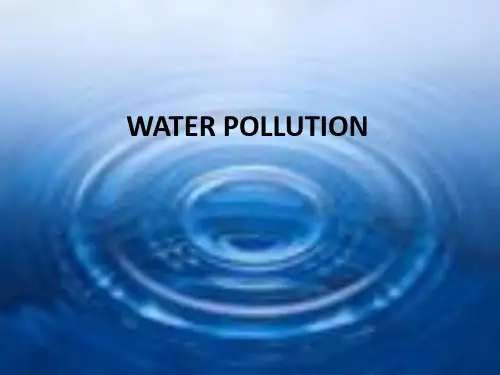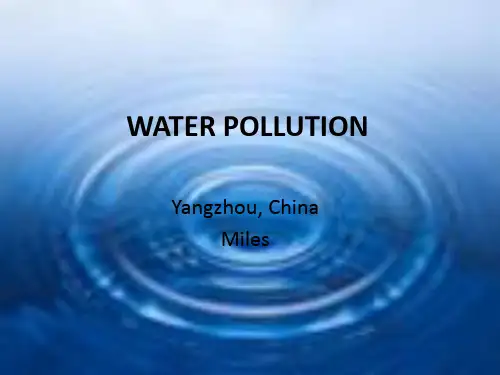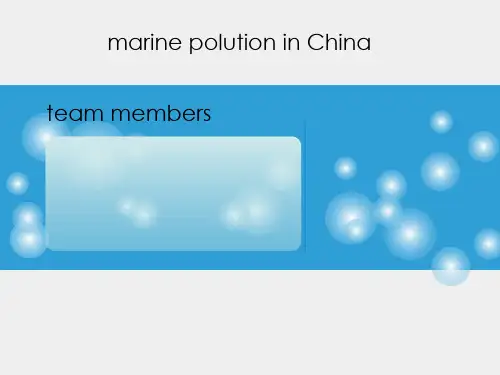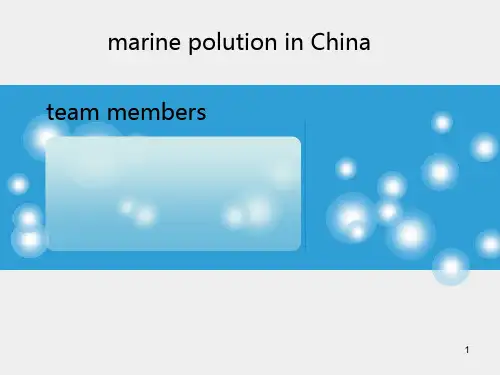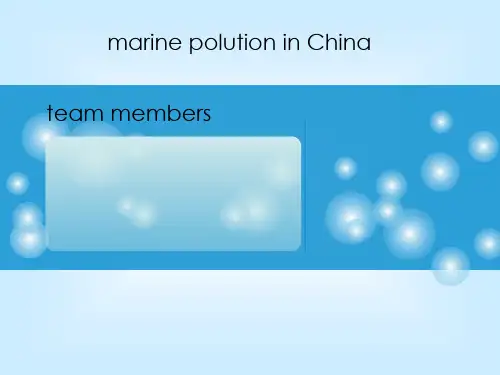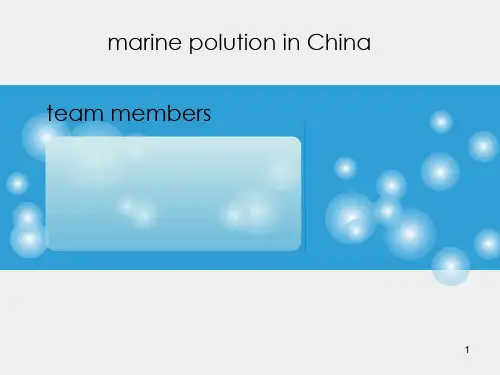海洋污染英文演讲稿.ppt
- 格式:ppt
- 大小:2.81 MB
- 文档页数:14
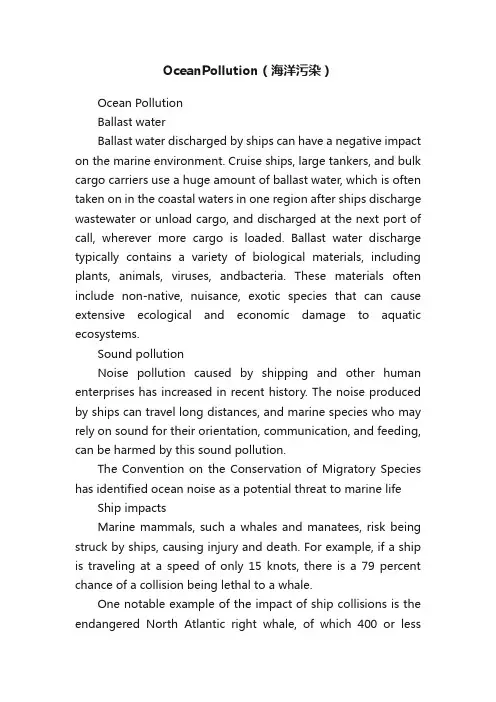
OceanPollution(海洋污染)Ocean PollutionBallast waterBallast water discharged by ships can have a negative impact on the marine environment. Cruise ships, large tankers, and bulk cargo carriers use a huge amount of ballast water, which is often taken on in the coastal waters in one region after ships discharge wastewater or unload cargo, and discharged at the next port of call, wherever more cargo is loaded. Ballast water discharge typically contains a variety of biological materials, including plants, animals, viruses, andbacteria. These materials often include non-native, nuisance, exotic species that can cause extensive ecological and economic damage to aquatic ecosystems.Sound pollutionNoise pollution caused by shipping and other human enterprises has increased in recent history. The noise produced by ships can travel long distances, and marine species who may rely on sound for their orientation, communication, and feeding, can be harmed by this sound pollution.The Convention on the Conservation of Migratory Species has identified ocean noise as a potential threat to marine life Ship impactsMarine mammals, such a whales and manatees, risk being struck by ships, causing injury and death. For example, if a ship is traveling at a speed of only 15 knots, there is a 79 percent chance of a collision being lethal to a whale.One notable example of the impact of ship collisions is the endangered North Atlantic right whale, of which 400 or lessremain. The greatest danger to the North Atlantic right whale is injury sustained from ship strikes. Between 1970 and 1999, 35.5 percent of recorded deaths were attributed to collisions. During 1999 to 2003, incidents of mortality and serious injury attributed to ship strikes averaged one per year. In 2004 to 2006, that number increased to 2.6. Deaths from collisions has become an extinction threat.Exhaust emissionsExhaust emissions from ships are considered to be a significant source of air pollution, with 18 to 30 percent of all nitrogen oxide and 9 percent of sulphur oxide pollution. The 15 biggest ships emit about as much sulphur oxide pollution as all cars combined. "By 2010, up to 40 percent of air pollution over land could come from ships." Sulfur in the air creates acid rain which damages crops and buildings. When inhaled the sulfur is known to cause respiratory problems and even increase the risk of a heart attack.According to Irene Blooming, a spokeswoman for the European environmentalcoalition Seas at Risk, the fuel used in oil tankers and container ships is high in sulfur and cheaper to buy compared to the fuel used for domestic land use. "A ship lets out around 50 times more sulfur than a lorry per metric tonne of cargo carried." Cities in the U.S. like Long Beach, Los Angeles, Houston, Galveston, and Pittsburgh see some of the heaviest shipping traffic in the nation and have left local officials desperately trying to clean up the air. Increasing trade between the U.S. and China is helping to increase the number of vessels navigating the Pacific and exacerbating many of the environmental problems. To maintain the level of growth China is currently experiencing, large amounts of grain are being shipped to China by the boat load.The number of voyages are expected to continue increasing.Oil spillsMost commonly associated with ship pollution are oil spills. While less frequent than the pollution that occurs from daily operations, oil spills have devastating effects. While being toxic to marine life,polycyclic aromatic hydrocarbons (PAHs), the components in crude oil, are very difficult to clean up, and last for years in the sediment and marine environment. Marine species constantly exposed to PAHs can exhibit developmental problems, susceptibility to disease, and abnormal reproductive cycles. One of the morewidely known spills was the Exxon V aldez incident in Alaska. The ship ran aground and dumped a massive amount of oil into the ocean in March 1989. Despite efforts of scientists, managers, and volunteers over 400,000 seabirds, about 1,000 sea otters, and immense numbers of fish were killed.SewageThe cruise line industry dumps 255,000 gallons of greywater and 30,000 gallons of blackwater into the sea every day. Blackwater is sewage, wastewater from toilets and medical facilities, which can contain harmful bacteria, pathogens,viruses, i ntestinal parasites, and harmful nutrients. Discharges of untreated or inadequately treated sewage can cause bacterial and viral contamination of fisheries and shellfish beds, producing risks to public health. Nutrients in sewage, such as nitrogen and phosphorus, promote excessive algal blooms, which consumes oxygen in the water and can lead to fish kills and destruction of other aquatic life. A large cruise ship (3,000 passengers and crew) generates an estimated 55,000 to 110,000 liters per day of blackwater wasteSolid wasteSolid wastegenerated on a ship includes glass, paper, cardboard, aluminium and steel cans, and plastics. It can be either non-hazardous or hazardous in nature. Solid waste that enters the ocean may become marinedebris, and can then pose a threat to marine organisms, humans, coastal communities, and industries that utilize marine waters. Cruise ships typically manage solid waste by a combination of source reduction, waste minimisation, and recycling. However, as much as 75 percent of solid waste is incinerated on board, and the ash typically is discharged at sea, although some is landed ashore for disposal or recycling. Marine mammals, fish, sea turtles, and birds can be injured or killed from entanglement with plastics and other solid waste that may be released or disposed off of cruise ships. On average, each cruise ship passenger generates at least two pounds of non-hazardous solid waste per day. With large cruise ships carrying several thousand passengers, the amount of waste generated in a day can be massive. For a large cruise ship, about 8 tons of solid waste are generated during a one-week cruise. It has been estimated that 24 percent of the solid waste generated by vessels worldwide (by weight) comes from cruise ships. Most cruise ship garbage is treated on board (incinerated, pulped, or ground up) for discharge overboard. When garbage must be off-loaded (for example, because glass and aluminium cannot be incinerated), cruise ships can put a strain on port reception facilities, which are rarely adequate to the task of serving a large passenger vessel.Bilge waterOn a ship, oil often leaks from engine and machinery spaces or from engine maintenance activities and mixes with water inthe bilge, the lowest part of the hull of the ship. Oil, gasoline, and by-products from the biological breakdown of petroleum products can harm fish and wildlife and pose threats to human health if ingested. Oil in even minute concentrations can kill fish or have various sub-lethal chronic effects. Bilge water also may contain solid wastes and pollutantscontaining high amounts of oxygen-demanding material, oil and other chemicals. A typical large cruise ship will generate an average of 8 metric tons of oily bilge water for each 24 hours of operation. To maintain ship stability and eliminate potentially hazardous conditions from oil vapors in these areas, the bilge spaces need to be flushed and periodically pumped dry. However, before a bilge can be cleared out and the water discharged, the oil that has been accumulated needs to be extracted from the bilge water, after which the extracted oil can be reused, incinerated, and/or offloaded in port. If a separator, which is normally used to extract the oil, is faulty or is deliberately bypassed, untreated oily bilge water could be discharged directly into the ocean, where it can damage marine life.A number of cruise lines have been charged with environmental violations related to this issue in recent years。
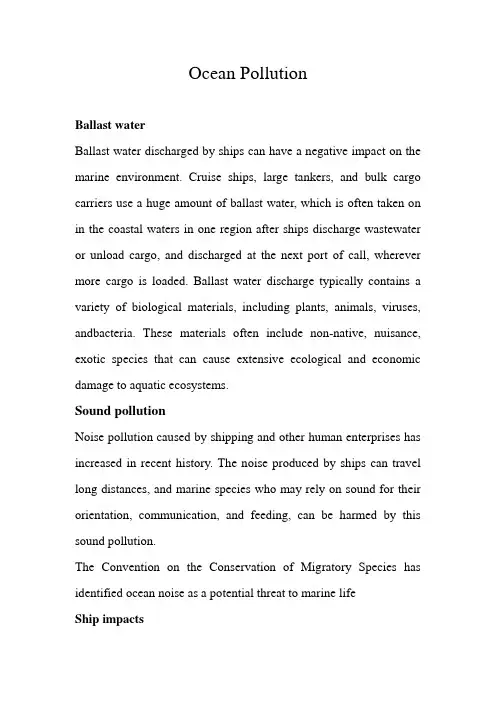
Ocean PollutionBallast waterBallast water discharged by ships can have a negative impact on the marine environment. Cruise ships, large tankers, and bulk cargo carriers use a huge amount of ballast water, which is often taken on in the coastal waters in one region after ships discharge wastewater or unload cargo, and discharged at the next port of call, wherever more cargo is loaded. Ballast water discharge typically contains a variety of biological materials, including plants, animals, viruses, andbacteria. These materials often include non-native, nuisance, exotic species that can cause extensive ecological and economic damage to aquatic ecosystems.Sound pollutionNoise pollution caused by shipping and other human enterprises has increased in recent history. The noise produced by ships can travel long distances, and marine species who may rely on sound for their orientation, communication, and feeding, can be harmed by this sound pollution.The Convention on the Conservation of Migratory Species has identified ocean noise as a potential threat to marine lifeShip impactsMarine mammals, such a whales and manatees, risk being struck by ships, causing injury and death. For example, if a ship is traveling at a speed of only 15 knots, there is a 79 percent chance of a collision being lethal to a whale.One notable example of the impact of ship collisions is the endangered North Atlantic right whale, of which 400 or less remain. The greatest danger to the North Atlantic right whale is injury sustained from ship strikes. Between 1970 and 1999, 35.5 percent of recorded deaths were attributed to collisions. During 1999 to 2003, incidents of mortality and serious injury attributed to ship strikes averaged one per year. In 2004 to 2006, that number increased to 2.6. Deaths from collisions has become an extinction threat.Exhaust emissionsExhaust emissions from ships are considered to be a significant source of air pollution, with 18 to 30 percent of all nitrogen oxide and 9 percent of sulphur oxide pollution. The 15 biggest ships emit about as much sulphur oxide pollution as all cars combined. "By 2010, up to 40 percent of air pollution over land could come from ships." Sulfur in the air creates acid rain which damages crops and buildings. When inhaled the sulfur is known to cause respiratory problems and even increase the risk of a heart attack.According to Irene Blooming, a spokeswoman for the European environmentalcoalition Seas at Risk, the fuel used in oil tankers and container ships is high in sulfur and cheaper to buy compared to the fuel used for domestic land use. "A ship lets out around 50 times more sulfur than a lorry per metric tonne of cargo carried." Cities in the U.S. like Long Beach, Los Angeles, Houston, Galveston, and Pittsburgh see some of the heaviest shipping traffic in the nation and have left local officials desperately trying to clean up the air. Increasing trade between the U.S. and China is helping to increase the number of vessels navigating the Pacific and exacerbating many of the environmental problems. To maintain the level of growth China is currently experiencing, large amounts of grain are being shipped to China by the boat load. The number of voyages are expected to continue increasing.Oil spillsMost commonly associated with ship pollution are oil spills. While less frequent than the pollution that occurs from daily operations, oil spills have devastating effects. While being toxic to marine life,polycyclic aromatic hydrocarbons (PAHs), the components in crude oil, are very difficult to clean up, and last for years in the sediment and marine environment. Marine species constantly exposed to PAHs can exhibit developmental problems, susceptibility to disease, and abnormal reproductive cycles. One of the morewidely known spills was the Exxon V aldez incident in Alaska. The ship ran aground and dumped a massive amount of oil into the ocean in March 1989. Despite efforts of scientists, managers, and volunteers over 400,000 seabirds, about 1,000 sea otters, and immense numbers of fish were killed.SewageThe cruise line industry dumps 255,000 gallons of greywater and 30,000 gallons of blackwater into the sea every day. Blackwater is sewage, wastewater from toilets and medical facilities, which can contain harmful bacteria, pathogens,viruses, i ntestinal parasites, and harmful nutrients. Discharges of untreated or inadequately treated sewage can cause bacterial and viral contamination of fisheries and shellfish beds, producing risks to public health. Nutrients in sewage, such as nitrogen and phosphorus, promote excessive algal blooms, which consumes oxygen in the water and can lead to fish kills and destruction of other aquatic life. A large cruise ship (3,000 passengers and crew) generates an estimated 55,000 to 110,000 liters per day of blackwater wasteSolid wasteSolid wastegenerated on a ship includes glass, paper, cardboard, aluminium and steel cans, and plastics. It can be either non-hazardous or hazardous in nature. Solid waste that enters the ocean may become marinedebris, and can then pose a threat to marine organisms, humans, coastal communities, and industries that utilize marine waters. Cruise ships typically manage solid waste by a combination of source reduction, waste minimisation, and recycling. However, as much as 75 percent of solid waste is incinerated on board, and the ash typically is discharged at sea, although some is landed ashore for disposal or recycling. Marine mammals, fish, sea turtles, and birds can be injured or killed from entanglement with plastics and other solid waste that may be released or disposed off of cruise ships. On average, each cruise ship passenger generates at least two pounds of non-hazardous solid waste per day. With large cruise ships carrying several thousand passengers, the amount of waste generated in a day can be massive. For a large cruise ship, about 8 tons of solid waste are generated during a one-week cruise. It has been estimated that 24 percent of the solid waste generated by vessels worldwide (by weight) comes from cruise ships. Most cruise ship garbage is treated on board (incinerated, pulped, or ground up) for discharge overboard. When garbage must be off-loaded (for example, because glass and aluminium cannot be incinerated), cruise ships can put a strain on port reception facilities, which are rarely adequate to the task of serving a large passenger vessel.Bilge waterOn a ship, oil often leaks from engine and machinery spaces or from engine maintenance activities and mixes with water in the bilge, the lowest part of the hull of the ship. Oil, gasoline, and by-products from the biological breakdown of petroleum products can harm fish and wildlife and pose threats to human health if ingested. Oil in even minute concentrations can kill fish or have various sub-lethal chronic effects. Bilge water also may contain solid wastes and pollutantscontaining high amounts of oxygen-demanding material, oil and other chemicals. A typical large cruise ship will generate an average of 8 metric tons of oily bilge water for each 24 hours of operation. To maintain ship stability and eliminate potentially hazardous conditions from oil vapors in these areas, the bilge spaces need to be flushed and periodically pumped dry. However, before a bilge can be cleared out and the water discharged, the oil that has been accumulated needs to be extracted from the bilge water, after which the extracted oil can be reused, incinerated, and/or offloaded in port. If a separator, which is normally used to extract the oil, is faulty or is deliberately bypassed, untreated oily bilge water could be discharged directly into the ocean, where it can damage marine life.A number of cruise lines have been charged with environmental violations related to this issue in recent years。

